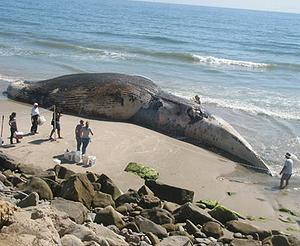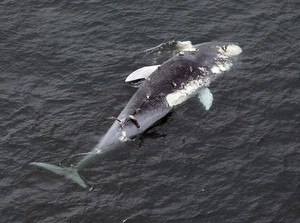As many as 200 blue whales, members of the largest species on Earth, have been feeding in the Santa Barbara Channel during their annual summer migration from Mexico and Central America. About 3,000 of the world's 12,000 blue whales swim off the west coast of the Americas.

|
| ©SBMNH |
| A necropsy was done on the first blue whale carcass found last week near Ventura, California. |
The latest dead whale was spotted Wednesday floating in the Santa Barbara Channel.
Plans to bring this 70 foot male whale, weighing more than 50 tons, ashore began today.

|
| ©Stephen Osman, Los Angeles Times |
| Eager to examine the whale's tissue while it's fresh, scientists are making plans to tow the carcass to shore at Naval Base Ventura County at Point Mugu. |
According to Michelle Berman with the Santa Barbara Museum of Natural History, SBMNH, a team will assemble Saturday morning to bring the whale ashore near a naval base.
This afternoon SBMNH said the carcass was floating south of Platform Grace, an oil production platform in the Santa Barbara Channel.
Last week, a dead blue whale beached about 10 miles up the coast from Ventura and another was found in Long Beach Harbor before being towed out to sea.
These two whales, found with many of their bones broken, are believed to have been struck by ships in the busy shipping channel. It is not known yet if this latest whale suffered a similar fate.
Frances Gulland, director of veterinary science at the Marine Mammal Center in Sausilito, California and other biologists plan to examine the latest dead whale to determine if it may have been disoriented by some sort of illness.
Dr. Gulland says the appearance of these three whale carcasses is "a highly unusual event and may be an indicator of an unusual mortality event." She was one of the scientists who determined that the whale found north of Ventura had been hit by a ship.
That whale was a female sub-adult to adult about 72 feet long and weighing about 120,000 to 140,000 pounds, according to the Santa Barbara Museum of Natural History.
The whale was about three to five years old. She was not pregnant and was most likely not of breeding age.
A necropsy conducted last Friday and Saturday by that Marine Mammal Stranding Network, the Santa Barbara Museum of Natural History, the Marine Mammal Center and the Channel Islands Marine and Wildlife Institute revealed that the most likely cause of death was a ship strike along the back side of the whale. Date, time, and exact location of the incident and death are unknown.
Scientists were able to collect tissue samples which were taken for biochemical and genetic testing. The results will be available in about a month.
The skull and some of the broken vertebrae were harvested by the Santa Barbara Museum of Natural History. The museum had hoped to collect the whole skeleton, but the bones were too badly damaged.
While the museum is responsible for conducting necropsies on stranded marine mammals in this area, the owner of a beach where a mammal has stranded is responsible for disposal of the carcass.
As the responsible owner, Ventura County decided to move the whale to a beach site just outside Faria County Beach, about two miles south of the original stranding point.
Paul Collins, curator of vertebrate zoology at the museum, says it is normal for large sized ships and tankers to be in the Santa Barbara Channel, as it is normal for blue whales to be in the channel. This particular summer, there seems to be greater numbers of blue whales in the channel, possibly due to richer food sources.
The museum has reported only six other blue whale strandings since 1980.



Reader Comments
to our Newsletter